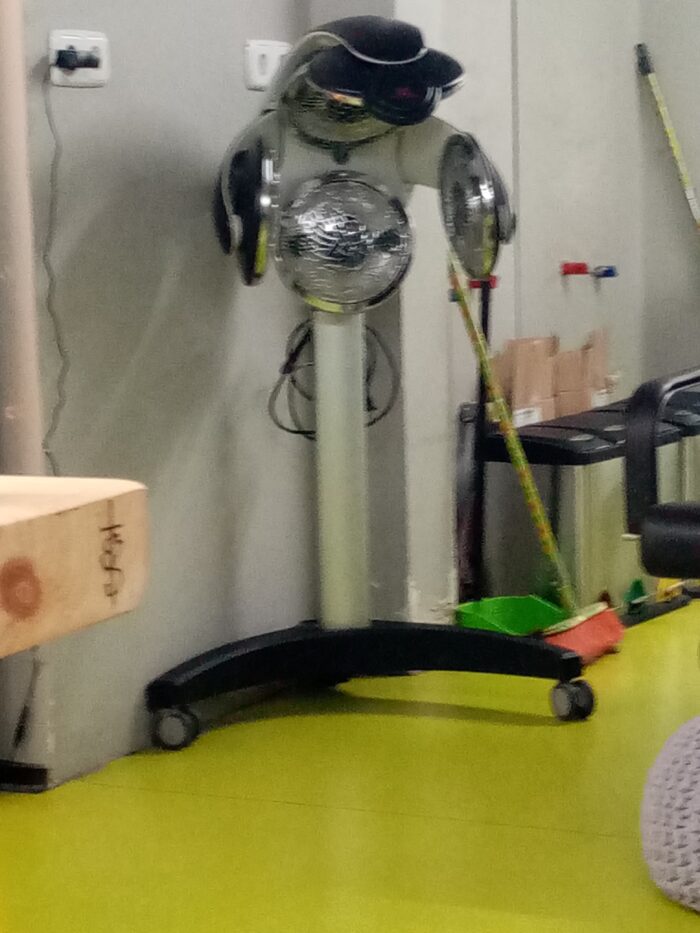surface ornament frivolity
All blondes say they are young
A previous version of this text was originally published in the catalogue of El Hecho Alegre/The Happy Fact, held at La Casa Encendida Madrid, in 2019 curated by Tania Pardo.
“A world wholly alive has a hellish power.”—Clarice Lispector
We only have the surface. Our language knows it, because the word has no opposite. There is no such thing as insurface or asuperficial; and concepts like “bottom” or “depth” are not exact antonyms either as we often access them through the upper layers, sliding away different surfaces. If we cannot possibly touch anything but the facade of what is being shown, what do we gain by turning language on its head, by looking for the “non-superficial”? Rotating words, twisting them to tease out other possibilities can lead to the discovery, not so much of something secret—more valuable than anything we have seen—but of another equally fabricated, interpreted—maybe malignant—part. Take the word action for example: what is the opposite of an “act”? It can’t be to “stop” because one can decide to do that, which implies an act. Neither do things like “deact” (if it actually existed), or “inaction” work, because they describe processes, which inevitably imply action. The opposite of action is probably passion. We don’t act when in the throes of our passions because passion is something that happens to us, that we give ourselves up to (passively). It sounds suspicious, for example, to say that someone “acts on love”.

Similarly, the ornament is more alive than life. It operates in several of our senses and can be defined as the change on the surface that attempts to bring us to a halt. It is a characteristic of the space that influences our time, and in fact the more effective the ornamentation, the more we stop to try and distinguish it. Although an ornament is never distinguished. An ornament can be overlooked completely or it can just be plain. It is always mixed up (submerged, almost) with the rest of its setting. Again, the ornament is what makes us stop: a sign, an announcement, a neon light, a sting, a kneepad. For example, a tumble, a collision, would be an ornament viewed with disfavour (in other words, a reproachable but frequently efficient ornament). J.G. Ballard’s novel Crash operates like a torrent for this kind of ornamentation. In a 1970 interview for Penthouse, the author summed it up as follows: “A car crash harnesses elements of eroticism, aggression, desire, speed, drama, kinaesthetic factors, the stylising of motion, consumer goods, status—all these in one event. I myself see the car crash as a tremendous sexual event really: a liberation of human and machine libido (if there is such a thing).” The most successful ornament is the one that exerts the most power of seduction, because ornament and sensuality go hand in hand. When we speak of “sensual forms”, we often refers to those fine curved lines coiled one on top of the other, but sensuality can be flat and unchanging. Smooth, cold, reflective, bitter, arid, rough. An ornamented surface may be austere. Ornamentation can not only occur without adornment, but can actually be more effective that way: when there are no witnesses. In other words, ornamentation is the act of seduction without realization. When we are asleep ornamentation thrives in our snores. To breathe during sleep with a rough hoarse noise due to the vibration of the soft palate; snoring is the epitome of ornamentation.
One year ago, I went to that contemporary art fair. For reasons that are still to be discovered, I had been invited to a very fancy dinner on the upper floor of a legendary restaurant in the centre of the city. The place had recently been renewed and now wore a spiral staircase covered with mirrors, mini neon lamps, and orange corbel moulding, made out of plaster. All I obtained from such an upscale occasion was a wild conversation with someone who dedicates himself to the production of lavish and enormous art objects, a jacket-clad New Yorker who works in admin and the female assistant of the event. Almost certainly, what brought the four of us together into a separate table was either a mistake or neglect, since it could be said that each of us was a kind of residual guest. Not the guests that make the party happen or the ones who everyone is waiting for, but rather stuffing people; those who are easily interchangeable and not much needed, but who may help to produce a certain vibe, or be useful to prevent silence. Having this in the back of my mind, our forced nocturnal conversation required significant effort and commitment. It felt like a job interview where one is trying hard to show that s/he is capable of dealing with some irrelevant task; telling oneself to exaggerate the gestures of being listening while showing confidence and looking smart. Naturally, when our brain is giving us specific performing commands such as “fix the gaze, straight back, look at his tongue, hands on the table, nod”, it’s hard to simultaneously uphold a verbal conversation that is as engaging as we are pretending it is. If extended enough in time, good manners begin to blend into one another, and produce facial expressions and body contortions that resemble those of epileptics. The discussion with my diners over the course of the evening included massive misunderstandings as well as distortions of common sense, which we tacitly agreed not to point out. The art producer announced that he knew there is an upcoming war between Germany and France. Everyone was giggling inopportunely.
Unsurprisingly, my friends were amazed by the fact that I had been invited to that dinner. I sent them sneaky pictures of the baroness sitting near to us, at another table, while she was making a toast. The following day I accompanied these friends to the hospital and one of them needed a stick, so I remembered how I had noticed many of those gadgets at the last Frieze: “sticks must be classy”, I had guessed back then. At 2pm, I saw the missed phone call from the other friend and took a deep breath before calling back. She immediately told me that the treatment had been effective: the malaise had stopped and it was her birthday the day after. Just like it will be her birthday again in two days. Last year, I was having dinner with aristocrats and art producers today, and weeks later he was being buried, on one of the sunniest days.
After the phone call I was too happy to stay still. The enormous lava-like positiveness within myself urged me to do something with it. I was about to erupt at noontime in the centre of dry Madrid, so I went straight to a hairdresser and turned myself into a blonde. Blondiness as the ultimate enactment of joy, blondiness as saying that it will be fine and you want it all, blondiness because it’s easy, fun, and modern. All blondes say they are young. A euphoric representation of the self right there, falling into the unavoidable fantasies that come with paying an unclear tribute to Brigitte, Marlene, Grace, Marisol, Raffaella—probably to Kurt on the rainy days—to Madonna, Marilyn and them all. It’s not just a color, (it is never just a color), but performing of a big collective worldview and an embodying of true fakes. It’s worth bearing in mind that blonde requires bleaching, and this means that the eye-catching look is harsh to the touch, and will certainly scratch your face and the faces of those who lie close to you. Blondiness then favors the construction of an image over its practicalities. Blonde made sense.


Death could also be acknowledged with a little mirth, with a little more frivolity. The word frivolus, which evolved into frivolous, was used to refer to cheap, useless clay vessels of little value. To any old clay. This material is modest enough to begin with, but when it is used to make a trivial object, that insignificant status is multiplied exponentially. Suddenly we find that the frivolus object is weighted down by an exaggerated humbleness: it becomes ridiculously banal. So frivolus, once used to describe a worthless object, has evolved into frivolous, referring to someone who has no thought for anything serious or important and who instead chooses to focus on the lightweight things in life. In fact, lightweight, something that weighs very little, harks back to the origins of frivolus. Faced with a weighty subject like death—an authentic fat one—we would do well to lighten the burden. This matter of our dying (immense, unfathomable, voracious, tragic, valuable, true, etc.) gives rise to the construction of temples, which are the complete opposite of the frivolus pot, the second-rate clay vessel. And yet there is something much more moribund in the second element. It’s as if the value of the frivolus were so inconsequential that death seems to be constantly stalking it. Death is part and parcel of it, because no one would mind too much if it were to break. The fact is that we frequently put the frivolus in any old place, leave it out in the rain or store it without proper protection. We are careless with the frivolus, so it is only natural that it succumbs—or is on the verge of succumbing—to death. It is a moribund object from day one. In all likelihood, this frivolus thing gets on much better with death than any other thing. Which is why nowadays adopting a frivolous attitude towards death is said to signify a healthy relationship with it. Numerous deaths occur every day. This reminds me of the Dialogue between Fashion and Death that Giacomo Leopardi wrote in the eighteenth century. Fashion says to her sister Death, “I say then that our common nature and custom is to incessantly renew the world. You attack the life of man, and overthrow all people and nations from beginning to end; whereas I content myself for the most part with influencing beards, head-dresses, costumes, furniture, houses, and the like. It is true, I do some things comparable to your supreme action. I pierce ears, lips, and noses, and cause them to be torn by the ornaments I suspend from them. I impress men’s skin with hot iron stamps, under the pretence of adornment. I compress the heads of children with tight bandages and other contrivances; and make it customary for all men of a country to have heads of the same shape, as in parts of America and Asia. I torture and cripple people with small shoes. I stifle women so they stay so tight that their eyes start from their heads; and I play a thousand similar pranks.” To say that death operates like fashion is frivolous and even makes us laugh. Laughter is how we react to something we can’t understand. If mirth describes anything, it is the interference of life in our systems of reasoning. That gag, lol or hahaha is simply the interruption of the mechanics that we have built for ourselves. We fill what we don’t understand with laughter. The straight line that moves forward, clear, uniform, eventually becomes life.
Proper laughter decomposes the head. In Spanish “des/ternillarse” (abandonment to hysterical laughter) means that “the ternillas are lost.” This term refers to the cartilaginous mortar that joins our jaws with the skull. In other words, desternillarse implies that laughing outrageously (making sudden movements, with a swinging jaw), includes the risk of causing the fracture and consequent dislocation in the “sesera” (brainpan).
In those who suffer from delicate heart conditions or choking, laughter may cause death, but death also leads to a lot of laughter: “to laugh one’s head off”. Unsurprisingly, this English expression comes from a historical episode of public decapitation. April 19, 1747 was the date chosen to carry out the execution of the depraved Lord Lovat in Tower Hill, London. This extremely popular sentence brought together thousands of individuals eager to enjoy the show. Just before the executioner brought his aze down on Lord Lovat’s neck, a scaffold full of spectators collapsed, suddenly killing 20 of them. It seems that when he witnessed the unexpected death of those who were there to contemplate his own, Lord Lovat burst out laughing, so the axe caught him in that way: full of joy. We can suspect that his laughing head, collapsing from the bloody trunk and then rolling across the stage, felt some dizziness or even vertigo, again.
As we see, laughing has little good or fun. It consists of a lubricant that brings us closer to others. That gag, lol, or hahaha are simply the interruption of the mechanics we have built for ourselves. We fill what we don’t understand with laughter. The straight line that moves forward, clear, uniform, eventually becomes life.

The author would like to acknowledge those who significantly helped her by reading and talking about this text: Leticia Ybarra Pasch, Andrés Carretero, and Louis Mason, together with Darya Diamond, Rafael Pérez Evans and Blythe Cain.





